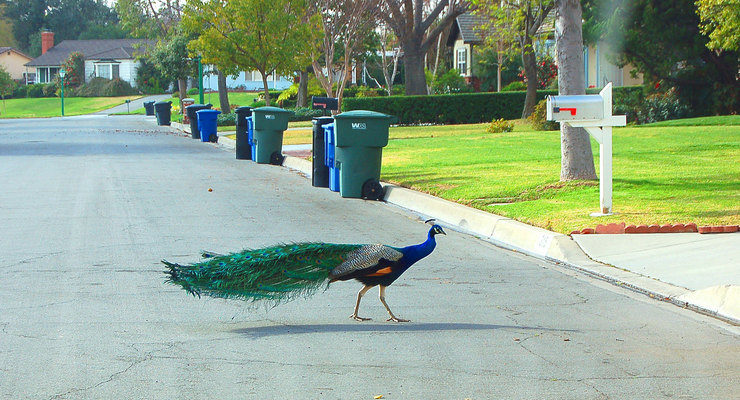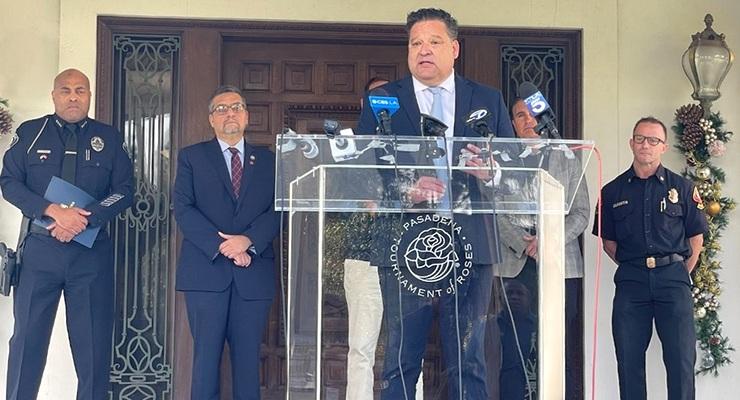
The Los Angeles County Board of Supervisors on Tuesday is expected to take up a proposed ordinance prohibiting the intentional feeding of bold and beautiful but also loud and messy peacocks, which have been strutting around East Pasadena, Arcadia, San Marino and other West San Gabriel Valley communities for decades.
“People should not be feeding these peacocks, pure and simple,” L.A. County Supervisor Kathryn Barger recently told the Washington Post. Barger, who lives in San Marino and represents Pasadena, Arcadia, as well as unincorporated East Pasadena and Altadena, said a peacock was recently run over by a car in her neighborhood.
Her proposed ordinance is modeled after a law in effect since 1979 in Arcadia, home to the L.A. County Arboretum and Botanic Gardens, which more than 100 of the colorful peafowl consider home.
“Some of the people are coming from a good place,” Barger said of those who try to take care of the petulant peacocks who wander onto their property. “But it’s not good for that population. And it is adding to the numbers that we’re seeing.”
As the Washington Post reported, it was unknown exactly how many of the prolific breeders there are, but when they come around they make their presence known with loud shrieks. They are the descendants of several pairs of the exotic fowl brought here from India by Arcadia founder Elias Jackson “Lucky” Baldwin, whose former property is now the arboretum.
The term “peacock” is commonly used to refer to birds of both sexes. But technically, only males are peacocks. Females are peahens, and together they are called peafowl. A peafowl is defined as “a large crested pheasant native to Asia.”
The board of supervisors vote comes as the county and a handful of area communities have resumed a peafowl relocation program.
“The program came to halt in the months leading up to the coronavirus pandemic, a time when Virulent Newcastle disease led to the deaths of more than 1 million birds, mostly chickens, and put Southern California’s entire poultry industry on lockdown until it was declared over last year after no more fowl tested positive for the deadly and highly transmissible virus,” the Washington Post’s Erica Werner explained.
Virulent Newcastle disease, Werner writes, does not pose a health risk to humans. But it is similar ro COVID-19 in as much as how quickly it can spread, and there is no reliable cure.
Some, like Nancy Adams of East Pasadena, welcome the peacocks, with their colorful plumage, to their neighborhoods.
“I love them,” the 67-year-old Adams said, “I know there’s people here that don’t like them. I say, ‘Why don’t you move?’”
Adams said keeps a bowl of water on her porch for the birds and feeds them occasionally. She objects to the county’s relocation project.
“I don’t know why they feel they need to do that,” Adams said.
Others, like Adams’ neighbor Kathleen Tuttle, however, said they have had enough.
“They wake me up at dawn. They sound like babies being tortured through a microphone, a very large microphone. And that is probably the start of my complaints,” Tuttle, 68, a retired prosecutor who lives in East Pasadena, told the newspaper.
Arcadia Deputy City Manager Michael Bruckner said he’s “pretty sure” no one’s been prosecuted or fined under that city’s no-feed law. Instead, he said publication of the ordinance serves as a reminder that peacocks are wildlife and should not be interfered with.
“They’re part of the aesthetic and fabric of the community … but we do recognize that it is a wild animal,” Bruckner said.
Mike Maxcy, a former curator of birds at the Los Angeles Zoo, now operates a company that contracts with city and county governments to move peacocks from residential neighborhoods to large ranches or farms where they can run free with ostriches or other animals.
“It’s the most polarizing thing I’ve ever been involved with,” Maxcy said. “Seventy percent of the population hate them and want them out. … Thirty percent love and cherish them,” he said.



















